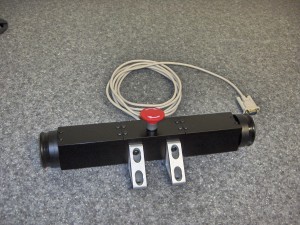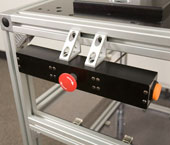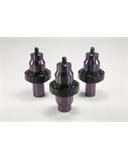Dukane Advances the Ultrasonic Delivery System
Ultrasonic welding has been in existence as an assembly process for over 40 years. As a method of bonding plastics, it has become one of the most accepted processes because it is clean, energy efficient and fast.
The birth of ultrasonic welding was discovered quite by accident, as many modern marvels are similarly invented. In the early years of the technology, the energy was applied to the plastic part by an operator who would manually pull the lever arm of an arbor press, which held an ultrasonic transducer and horn. In those days, the pressure would vary during the process and the amplitude would droop tremendously as the load was applied to the material. The process control was crude, but an industry had been launched.
During the late 1960’s and early 1970’s, ultrasonic machines were produced with pneumatic delivery systems and manufacturers called these components, presses or actuators. As a means for delivering the converter and the horn to the plastic, these systems were significantly advanced when compared to the previous hand controlled choice. In the 1980’s and 1990’s new products were produced that controlled the amount of energy delivered to the plastic. Ultrasonic welding machines were developed allowing welding by distance. Other significant electronic advances were made to the power supplies to control amplitude and stay current with the digital revolution. However, the delivery system for bringing the vibrating horn to the plastic has continued to be the standard actuator or press comprised of pneumatic components.
Back in the mid 90’s I predicted that I would be surprised if by the year 2000 manufacturers of ultrasonic plastic welding equipment had not incorporated the servo controlled technology into their standard product line. It just made sense. These innovative machine motion control systems provide the ability to control and profile force with the acceleration and deceleration features embellishing the welding process. I thought that servo controlled ultrasonic systems would become as common place as servo controlled injection molding machines.
Wow was I way too early with my prediction. However, one manufacturer has finally seen the light. Dukane has developed a new delivery system that looks like it could provide users a degree of control not previously realized in the industry. I am sure it is expensive and not meant for all applications, but for those companies looking for precise control of the process it is probably worth investigating.
Gary Clodfelter
Plastic Assembly Technologies, Inc.
Remote Palm Buttons for Branson Welders
Plastic Assembly Technologies has a line of remote palm buttons for Branson 900 and 2000 series ultrasonic welders. PAT’s Remote Palm Buttons are used to initiate the start of your Branson 900 & 2000 series welding equipment. These ERGO friendly palm buttons are easy to install and mount on most tables. The palm buttons are often used to allow removal of the welder from an automation line and cycle the welder independent of the automation.


- Features of the PAT Palm Button Sets:
- PAT palm buttons initiate ultrasonic welder cycle
- All pre-wired for direct plug in to welder
- Includes emergency stop button to terminate cycle
- Includes 9’ cable and D shell connector
- Includes mounting hardware
- Built from aluminum tubing and aluminum plate
- PALM-1 includes light touch mechanical switches
- PALM-2 includes capacitive touch switches
- Easily adapt to Pat’s slim line welder table
Palm Button Set Models
PALM-1 Palm button set with (2) light touch start buttons and emergency stop button
PALM-2 PALM button set with (2) capacitive start buttons and emergency stop button
Plastic Assembly Technologies, Inc., located in Indianapolis, Indiana, has a complete line of accessories for ultrasonic welding.
Aluminum & Titanium Ultrasonic Boosters

Plastic Assembly Technologies has introduced a new line of aluminum and titanium rigid mount ultrasonic boosters without spanner wrench holes. Ultrasonic boosters without spanner wrench holes result in a reduction of stress location points on the booster and provide for boosters that are less prone to fail. Additionally, these boosters are all of the same length, allowing the user to change the amplitude of the converter, booster and horn assembly without affecting the length of the assembly. Therefore, the amplitude can be mechanically changed without requiring significant adjustment in the welder setup. The rigid mount design reduces deflection during the ultrasonic welding process providing for less potential variation during welding. The boosters are priced to reflect the cost of conventional boosters, but provide a host of additional benefits. The ratios of gain changes available are 1:1, 1.5:1, 2.0:1 and 2.5:1. The boosters are designed to fit in Branson or Dukane ultrasonic welders using 3.250″ diameter ring mounts. Plastic Assembly Technologies has developed a stack vise to ease the changeover.


